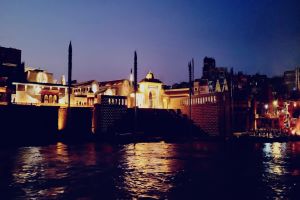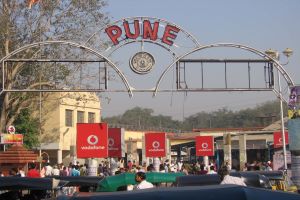Note: This post is the second in a two-part series covering a four-day personal trip to Varanasi. Please see this link for part I.
Background Knowledge
As one of the most sacred cities in South Asia, Varanasi is the final destination for several individuals seeking to be liberated from past sins as well as pilgrims seeking moksha or an escape from the cycle of birth and death, which is a central Hindu belief. It is believed that those who pass while in the city will attain moksha. There are even hospices such as Kashi Labh Mukti Bhawan, where the elderly can stay for a maximum of 2 weeks, technically to await their deaths in Varanasi. Then, there are routes that young people can take to abolish sins: bathing in the ganges, for example, or visiting one of the countless temples (including Kashi Vishwanath Temple) to obtain blessings.
Kashi Vishwanath Temple
Dedicated to Lord Shiva, Kashi Vishwanath Temple has shifted through various versions between 1194 and 1777. It was then later rebuilt in 1870 by the queen of Indore, Ahilyabai Holkar (after it was torn down by the ruthless ruler Aurangzeb) the Kashi Vishwanath Temple (Golden Temple) is one of the holiest and famed mandirs in Banaras. It is one of the 12 Jyotirlingas of Lord Shiva (The Jyotirlinga is a symbol dedicated to Lord Shiva wherein He is personified as a pillar of light.) Within all twelve Jyothirlinga shrines, the shivalinga represents the life force of Shiva.
In case you might be curious, below is a listing of the locations of the remaining eleven Jyothirlinga Shrines:
- Somnath, Gujarath
- Srisailam, Andhra Pradesh
- Ujjaim, Madhya Pradesh
- Omkareshwar, Madhya Pradesh
- Kedarnath, Himalayas
- Bhimashankar, Maharashtra
- Triambakeshwar, Maharashtra
- Deogarh, Jharkhand
- Dwarka, Gujarat
- Rameswaram, Tamil Nadu
- Grishneshwar, Aurangabad
Three defining features of Kashi Vishwanath Mandir include a golden spire, dome, and spire atop the Lord Vishwanath with a flag/trident. Fun Fact: In 1839, Maharaja Ranjit Singh donated 821 kg of gold to plate the striking golden spires. Below are a few stock photographs of the temple sourced from Google, since photography within the sacred space is limited to those with permits:



This iconic place of worship holds quite a bit of significance to devout Hindus, and has been at the heart of a heated debate among religious pilgrims as well as political leaders. Without delving too deep into the controversial issue, a mosque has been built near the premises of the temple, even though there have been numerous signs that the site of this mosque was originally a part of the temple. Needless to say, the desolate truth is that Hindus and Muslims remain warring parties to this day.
Several aartis occur at the Kashi Vishwanath temple throughout the day:
- Mangala Aarti: 3:00-4:00 AM
- Bhog Aarti: 11:15 AM- 12:20 PM
- Sapt Rishi Aarti: 7:00 PM- 8:15 PM
- Shringaar Aarti: 9:00 PM- 10:15 PM
Mangala Aarti & Sparsh Darshan at Kashi Vishwanath Temple
The Mangala Aarti which occurs around dawn, is the most auspicious of all of the aartis, as the sun is “pushing all of the energies from a sleeping to awakened stage” one or two hours prior to the sunrise.

Sparsh Darshan refers to the act of touching the shivalinga to absorb the strong spiritual energies and blessings from Lord Shiva. This is literally a stone imbued with the Lord’s life force. It should be noted that although in the past, the process of taking Sparsh Darshan was quite simple and accessible to anyone interested, the current political climate has led to increased security within the temple, and greatly limited the number of people allowed in its interior. Aarti tickets are often sold out weeks or months in advance. Couple this with the extreme popularity of this particular temple, as well as the zealousness of some of the religious pilgrims, and you will understand this great demand!
In addition, the temple has recently undergone an extravagant renovation which PM Modi led over the course of several years. This turned the originally 2,700 sq ft temple into a beautifully expansive 5 lakh sq ft compound built of red sandstone, local Chunar stone, Kota Granite and Makrana Marble and featuring four “decorative gateways”. On the flip side, the project unfortunately displaced lakhs of local shop and home owners.
For those who are interested in adding the special Sparsh Darshan experience to their itinerary, it may require doing a little bit of research ahead of time, or connecting with a “VIP”, who can pull some strings to obtain a last-minute ticket. In our case, we were fortunate that our guide had a personal connection to a temple staff member/ security guard, which made this experience possible for us.

Our Personal Spiritual Experience
So, now that you are aware of Kashi Vishwanath Temple’s historical significance, I will carry on with our personal experiences… Our most significant spiritual experience came on Saturday, almost in the dead of night. With hardly a chance to recuperate from the previous day’s incredibly busy schedule (detailed in Part I), we were expected to meet our guides by 3:00 AM early that morning to attend the Mangala Aarti and take “Sparsh Darshan” at the Kashi Vishwanath Temple.
As the clock struck 3:00, our timely guide and driver were parked in the small parking lot across from the Hotel Ganges View and ready to take us to the temple ground entrance. Since the entire experience was to occur so early, I hardly expected there to be a crowd… yet there was! As our van approached the temple’s vicinity, there were surprisingly hundreds of groups already milling about. We unexpectedly approached an electric night-time scene! We arrived a little early to be safe, so we had some time before the entrance gates opened, occupying a few plastic chairs placed along the road just across from the temple. Before long, our guides handed my father a packet of puja essentials to offer to the Lord. Typically, puja essentials include an assortment of offerings including flowers, leaves, coconuts, and powders including turmeric and chandan.
As it neared 4:00 AM, we made our way to the temple’s entrance, where a line was steadily growing in length. Again, as before, the crowd was packed, and right as the gates opened, a wild frenzy ensued. There was pushing, shoving, trampling and shouting… as if the pujaris within the temple were distributing large sums of cash or gold to all of the devotees (In truth, blessings and the chance to press your palm upon the shivalinga are priceless)! Within this chaos, one young Indian lady was brought to tears, as her golden chain had been snatched! The lesson: it is best to leave valuables at home or at your hotel when visiting the temple at this time of day!
Within about 10 minutes, we were crossing through the magnificent temple archways and stepping upon the striking speckled pearl marble flooring! At last! When we had finally entered the interior, I thought it was quite an overwhelming sight!
Unfortunately, we didn’t have much leisure time once we entered to appreciate this grandeur, as we were pressured forward into the inner “chamber” (pictured below) where the shivalinga was located. After approximately 10-15 minutes, we were again within a mad rush (but this one was actually quite frightening). As we neared the shivalinga, I realized I had exactly one second to force my arm through a network of hands/arms to reach the stone, without much as a chance to even glimpse what I was touching! So, this is just what I did – and before I knew it, I was thrust outside of the chamber by the mobile mass of devotees.

And at that exact moment (around 4:30 AM) I realized that what I had been anticipating for the past 12+ hours was over! A once-in-a-lifetime chance! I had touched the holy stone and felt the energy reverberate through my being!!! Part of this experience has certainly been internalized, but I, as a self-proclaimed devout individual, believe it to be true. In a way, this moment may have been anti-climatic as well, but I treasure it as a spiritual experience that will remain with me.
We spent the remainder of the next half-hour wandering through the vast temple grounds, obtaining blessings from the deities, and visiting the bull statue. Legend has it, if you whisper your deepest wishes into the bull’s ears, they will come true! We also strolled toward the back of the temple, toward the western-facing Manikarnika Ghat, which is the cremation ghat. Smoke-filled pyres, workers shoveling ash and orange fires blazing along the banks capture the image of the slightly chilling scene before us that dawn. I could hardly glance at this scene for longer than a few moments, even though I knew all along, that this was reality. It almost seemed surreal. We are so far removed from the concept of death – or perhaps, we remove ourselves from it intentionally, despite the fact that it is the inevitable conclusion to the life journey. At this point, it was perhaps 5:00 AM. Through the arched windows along the hallway on the back part of the temple, I caught a glimpse of the waning moon, which would fade into a splendid sunrise within just a few short hours. Once we returned to the large open area facing the chamber with the shivalinga, we were able to spend some time meditating. By then, most of the crowd had dispersed, creating a tranquil environment facilitating quiet prayer.
Breakfast In Vishwanath Galli
Upon departing the famous temple, we found ourselves traversing Vishwanath Galli, “one of the oldest and busiest streets in Varanasi”. While it was still dark (5:45-6 AM), our guide took us for a (very) early breakfast after departing Kashi Vishwanath Temple. Along the street leading up to the mandir, are several small streetfood vendors. It was within one of these streetside shops that we enjoyed bread and fresh loni or cream with a side of chai (pictured below).
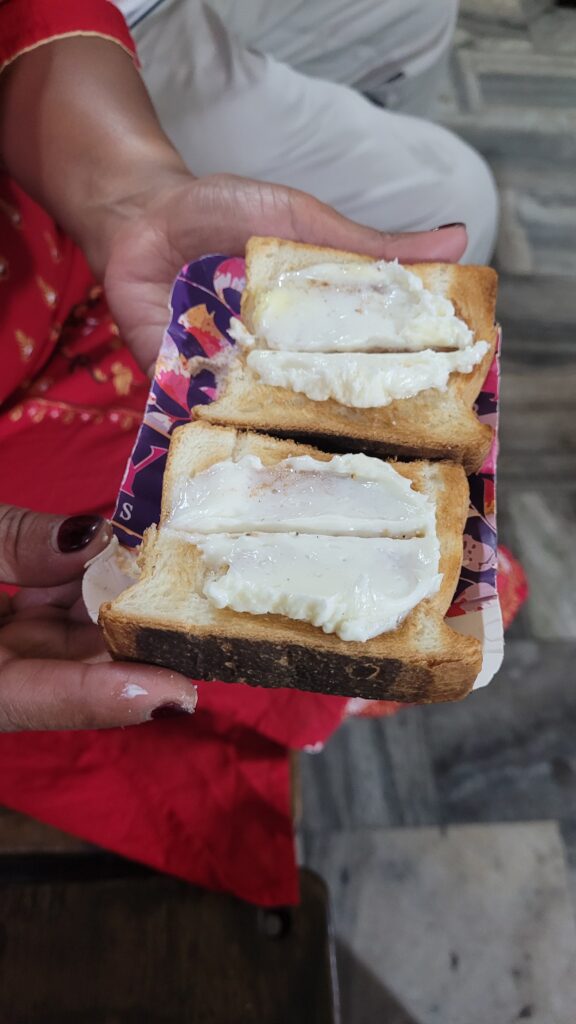
The Mirror Gift
We all returned to Hotel Ganges View just waiting to get some rest… Since we were all obviously quite sleep deprived by this time, every precious minute of sleep was prized! Thankfully, our guides did not have any plans for us until 11 AM, when we would check out of the Ganga-facing hotel and travel to Sarnath, a religious destination for Buddhist worshippers (more below on the site’s history).
Upon our departure, I was elated to receive a special parting gift from the Hotel Owner: A miniature peacock-green hand mirror! It was a simple souvenir, but it served as a very special memento from our royal hosts! It reflected the beauty of the city in which I received it! A fitting quote that I must insert here: “There are two ways of spreading light: to be the candle or the mirror that reflects it.” We all took darshan at the small shrine at the hotel entrance/exit before carrying our bags to our van and departing for Sarnath.

Tour of Sarnath
Once we were all settled in the van, the trip to Sarnath took between 30-45 minutes (13 km / 8 mi journey northwest of Varanasi) from Assi Ghat. There are several methods of travel, including rickshaw (300 rupees one way), buses or the Mahaparinirvan Express Buddhist Circuit Train via IRCTC. Upon our arrival, we identified a tour guide who spoke English, and began our tour. Tickets cost 300 rupees for foreigners and 25 rupees for Indians. An evening sound & light show also occurs every night around 7:30 PM at the Dhamekh Stupa.
Brief History of Sarnath
While a more detailed history of Sarnath is presented here, I will present a brief overview. Sarnath is notorious for being the place where the young prince Siddhartha Gautama (The Buddha) gave his first sermon after obtaining enlightenment and meditating under the Bodhi Tree in Bodhgaya. It is one of four main pilgrimage sites for devout Buddhists. The others include: Lumbini, Bodhgaya and Kusinagara. Once Buddhism became an official religion, an early convert, Mauryan Emperor Ashoka (ruled from c 279 B.C. to 232 B.C.E.) built several pillars and stupas dedicated to the practice throughout India, of which the most famous is located at Sarnath.
Key Sights of Sarnath
- Dhamekh Stupa Complex: Buddha delivered his first sermon here in the 6th century BCE.
- Sarnath Archelogical Museum: Contains five galleries of art and historical artifacts from Gautam Buddha’s time. Examples of what you may find include: Images and sculptures of the Buddha, Vajrapani and Bodhisattva, the crown of the Ashokan Pillar, and other statue fragments from the ruins.
- Ashokan Pillar: The most famous Buddhist Pillar. The column is topped with three significant symbols: Lotus Flower Base, A drum with four animal carvings (horse, ox, elephant and lion) and four lions roaring the four noble truths, which Gautam Buddha preached to his first disciples at this site. The lion is now the symbol of the Indian Government.
- Thai Temple & Monastery: A modern temple built in 1993, which is a beautiful tribute to the Thai culture.
- Chaukhandi Stupa: This stupa was constructed in the 5th Century AD and is the place where Gautam Buddha reunited with the panchavargiya bhikshus (5 companions).
- Garden of Spiritual Wisdom: A beautiful garden just behind the octagonal Chaukhandi Stupa.
- Mulagandha Kuti Vihar: A free monastery built in 1931 which contains a bell, golden Buddha statue upon a marble stage and walls splashed with scenes from the Buddha’s lifetime.
- Jain Mandir: Built in 1824, this glorious temple is located southwest of the Dhamekha Stupa and contains frescoes of the life of the founder of the Jain religion, Mahavira.
It is possible to see the entire museum and mandirs within 2 hours at a moderate pace, leaving an additional hour to meander through the colorful lanes facing the Dhamekh Stupa to do some street shopping. In our case, we spent some time here purchasing small gifts for friends, such as decorative Buddha statues and door hangings, before returning to the van. Below are some photos…
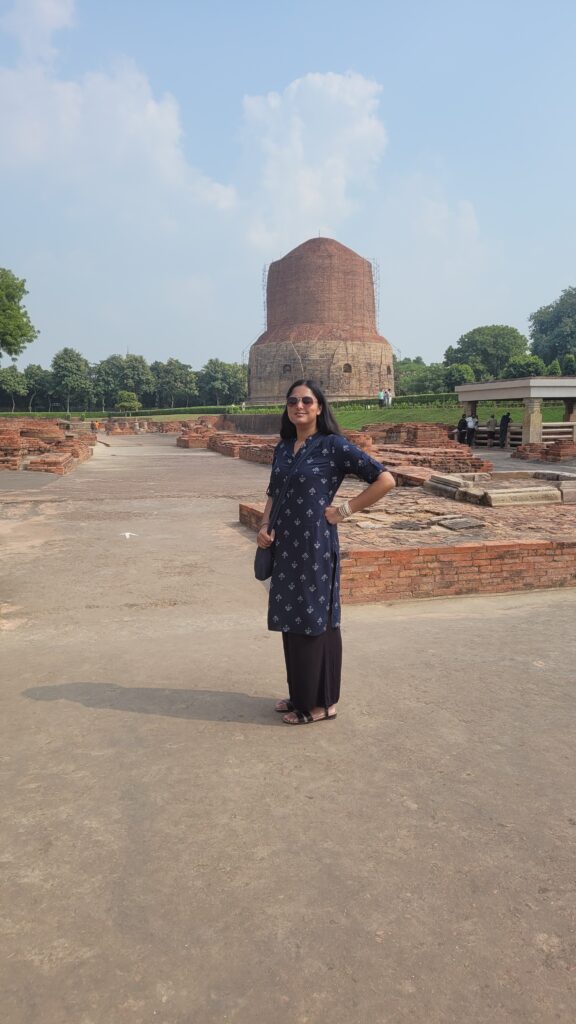

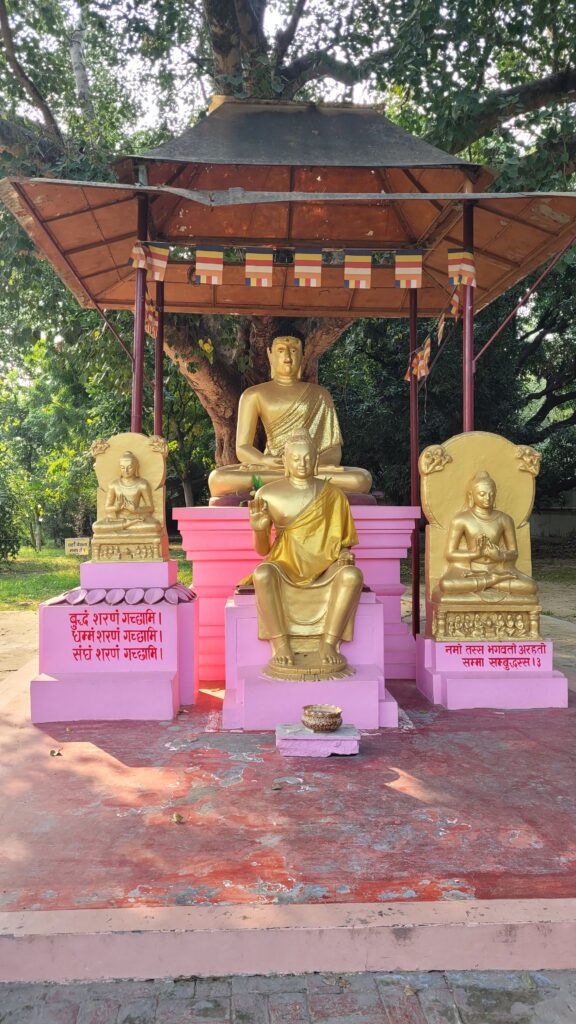
Checking into Taj Ganges Varanasi
For the final two nights of our stay in Banaras, we were truly lucky and pampered by staying at the luxurious Taj Hotel: A 5 Star residence. The grounds are breathtakingly beautiful, and as a guest, you will marvel at strolling amid jasmine fields and mango orchards galore. A curated photo selection of the hotel’s interior, grounds and lighted pool appear in the photo gallery below. Our party of four was again divided into two large rooms, each fitted with two queen-sized beds.
The imperial hotel is located on the Taj Nadeswar Palace Grounds, which holds historical significance: it was first built and occupied by the East India Company in the 1800s, followed by the Maharaja Prabhu Narain Singh of Banaras. Each room is named after a royal family member who has resided within its walls. There are only 10 rooms in this hotel, and each is brilliantly furnished, decorated with vintage items, and undeniably holds some secrets from its inhabitants. A particularly memorable space in the palace was the illuminated balcony overlooking a patio & garden, where a classical indian musical program was visible through the white stone balustrades.
We spent our evening exploring the palace grounds, and then passing through the hotel gates to explore the streets just beyond the palace hotel. On the first evening, we stopped for some ice cream at a local parlor. During the walk, I was struck by the sheer variety of street food vendors! Since it was just before Diwali, the streets were particularly busy (a common theme throughout my trip). Check out some photos of the hotel below…
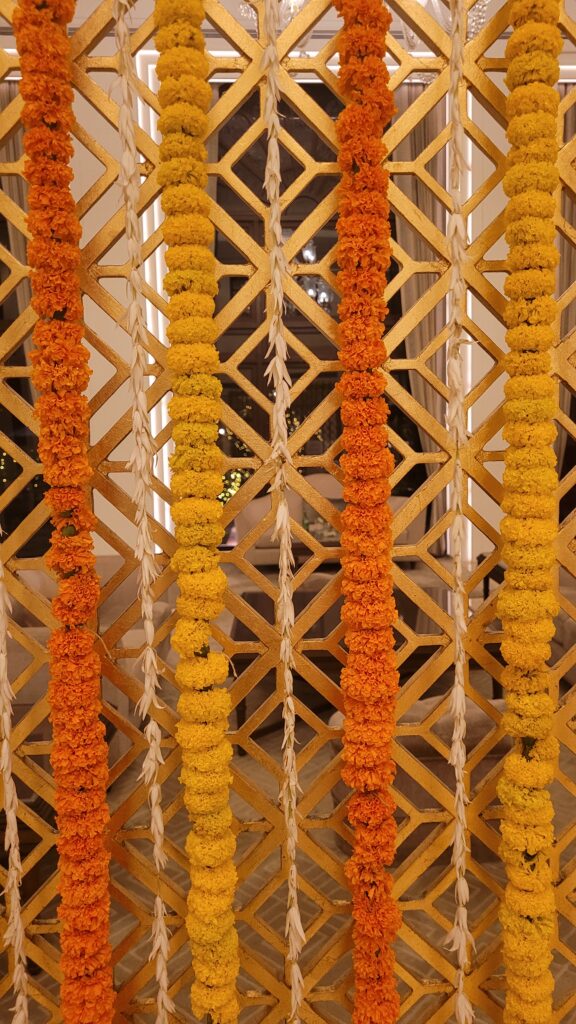
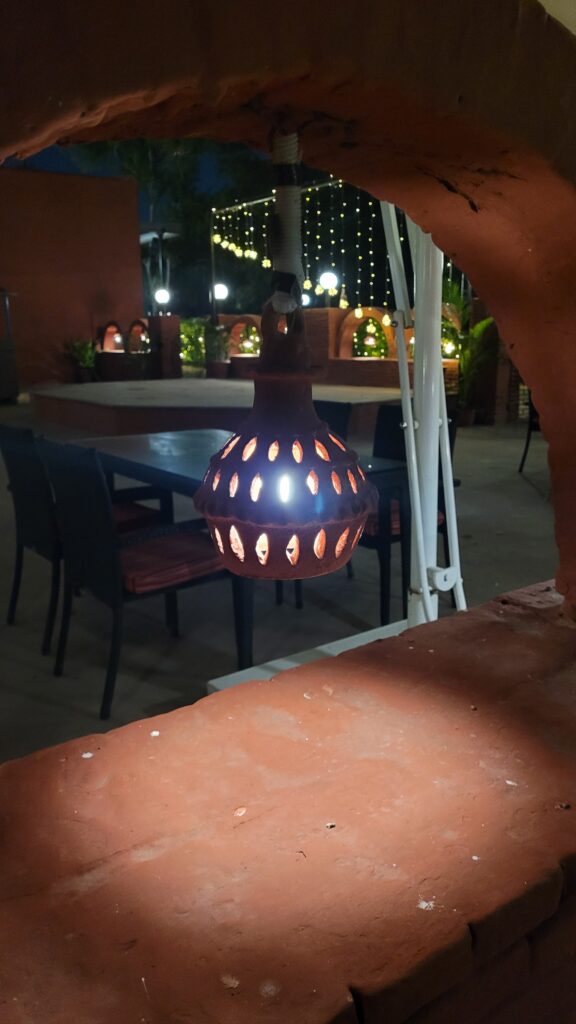
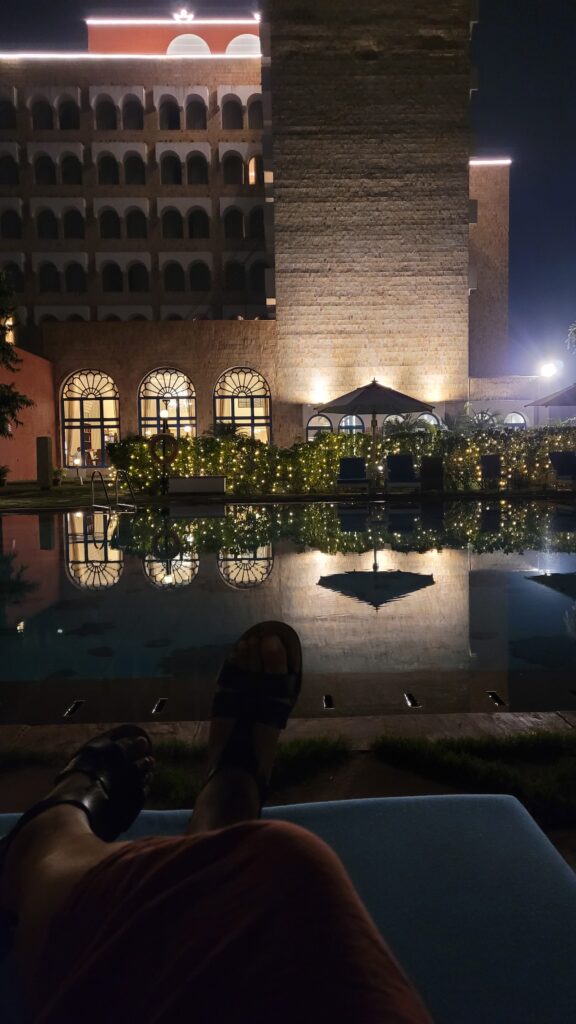
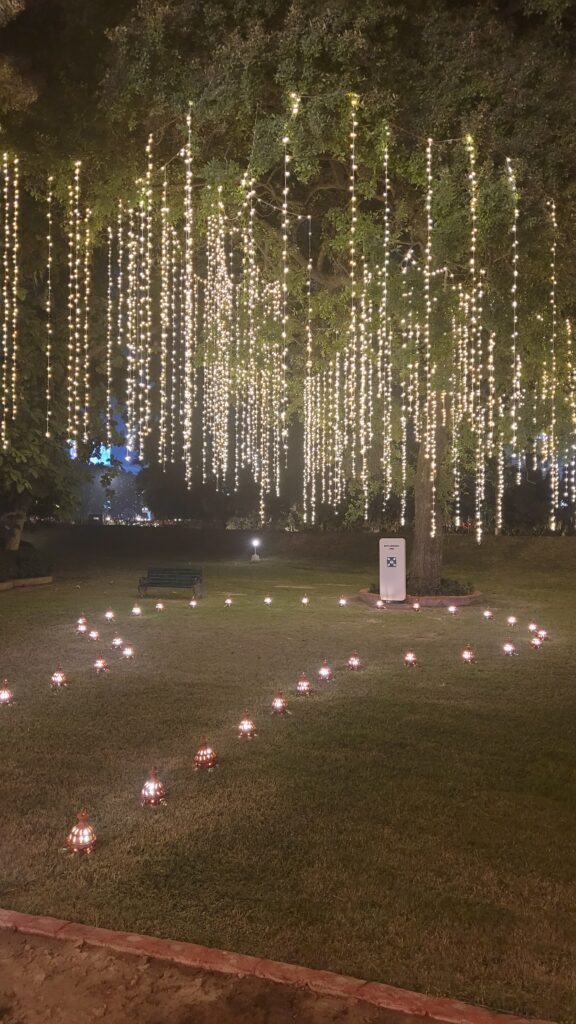
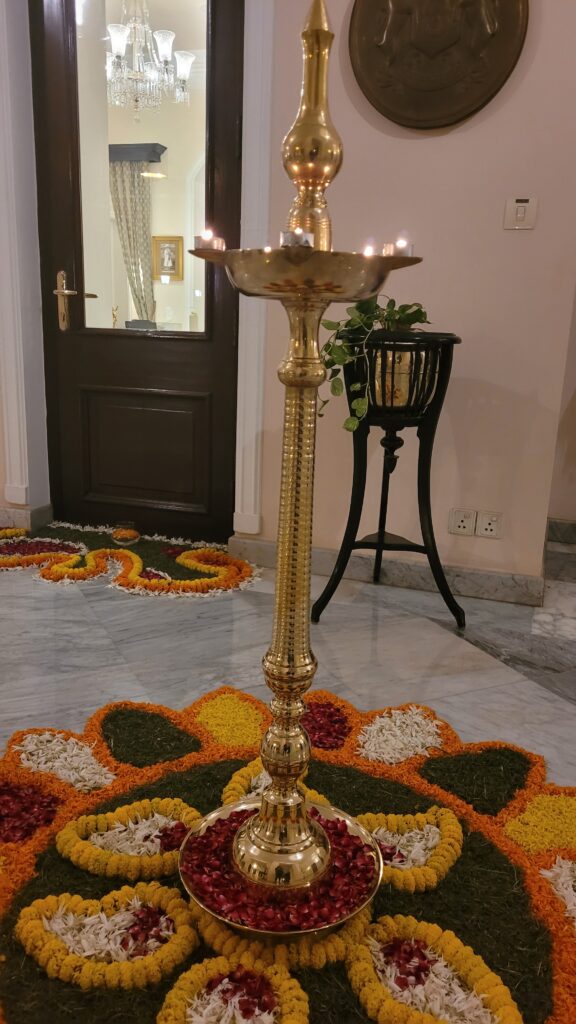

Sunday Morning Saree Shopping
The next morning, we awoke early to join my maternal grandmother’s acquaintance from her days residing in Banaras on a shopping extravaganza! Our purpose was to purchase sarees and gifts for friends back home. After leaving the hotel around 10:00 AM, our driver took us to pick up the friend, an elegantly dressed local lady in her sixties, from her house. Once she had joined my mother and I, we were off to our first destination, a saree shop: Leela. We were ushered in as the first customers of the day (lucky us!) It was smart to join a local while shopping in the city, as we were able to (I suppose) bargain and find a good selection of dresses. Banarasi shopkeepers can be quite relentless in displaying a variety of different styles and shades, almost pressurizing customers to purchase every single piece. It is so easy to be overwhelmed by the variety! Banarasi Silk Sarees are very well known, so we were searching for this unique style. After spending some time perusing and draping at least 4-5 different sarees, I selected a peach one with a golden paisley print pattern.
Chikankari Kurti Shopping
Our next stop was a small shop featuring an assorted selection of chikankari. This is a unique embroidered garment style (pictured below) that is actually imported from Lucknow. Thought to be of Persian origin, Chikankari is a very delicate shadow art craft which features delicate white yarn embroidery upon lightweight muslin fabrics. My mother and I purchased at least 3-4 different such kurtis from one vendor in shades of peach, white and navy for casual wear.
Next, we traveled to a small souvenir shop. Our only purchases here were unique gifts for those back home. I bought at least 10 banarasi silk hand purses for my co-workers, while my mother bought rust, navy and rose tinged silken table runners for some family friends.
Our final stop was a very high-end boutique in the midst of Varanasi’s shopping district, which stocked a very special selection of luxury and designer sarees. The store was a sight to see: four floors of fashionista heaven! Although it was a little overwhelming simply browsing, we knew we would not be the target market here when we learned that the starting price range was 15000 rupees! Regardless, it was a nice experience to browse. After the shopping outing, we returned to our hotel room to freshen up, before returning to the city for lunch.
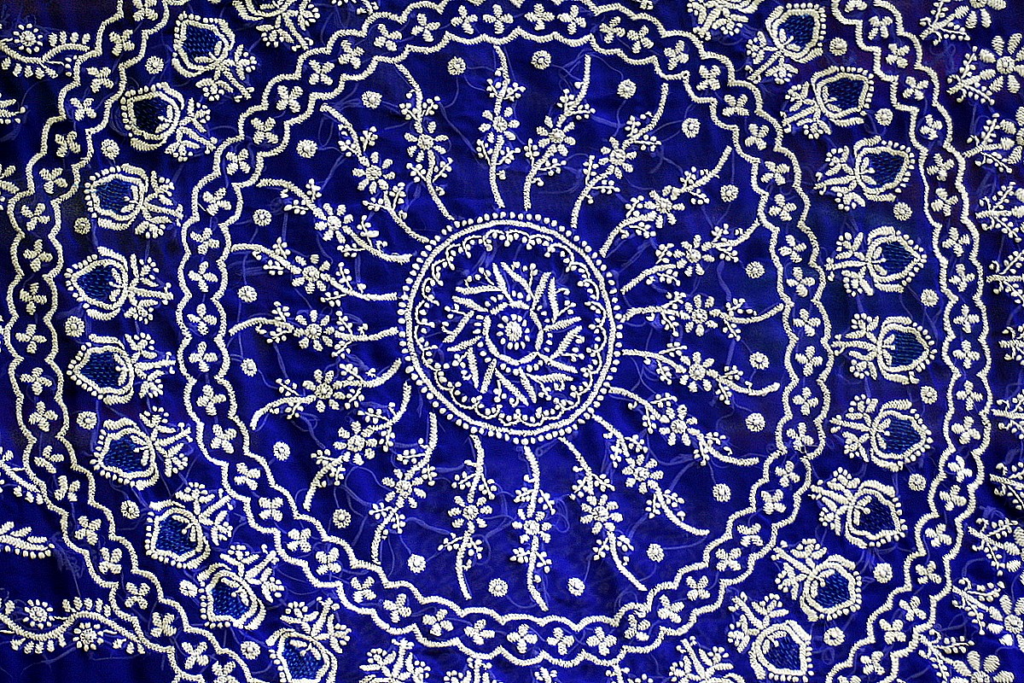
Lunch at Deena Chaat Bhandaar
We dined at a café & restaurant serving street food, specifically chaat (definition: a savory snack sold by street vendors that originated in the north). Our lunch consisted of a wide selection of such savory street foods. Rather than order separate dishes, we decided to share the following items in order to taste the greatest variety: Pani Puri, Samosa Chaat, Various Chutneys/ Dipping Sauces and Kachori, followed by delicious Kulfi for dessert. Photos of our dishes appear below.



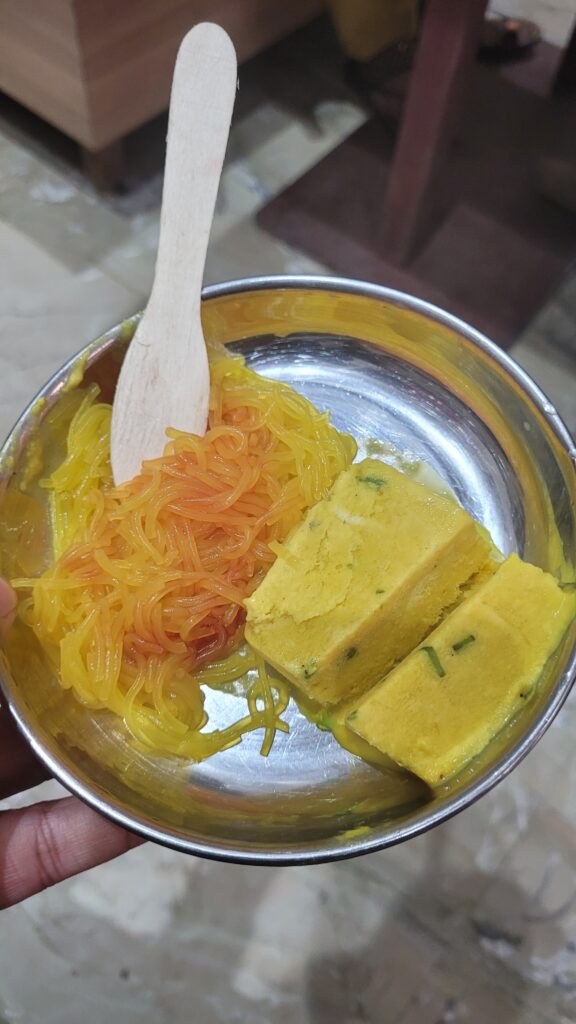
Banarasi Paan at Keshav Tambul Bhandaar
If you are an Indian film lover, you may have heard the well known tune, Khaike Paan Banaraswala from Amitabh Bacchan’s hit movie Don. The paan which this song mentions is truly a defining feature of the Varanasi food scene! Banarasi Paan is legendary. While visiting Varanasi, you must try it! Both locals and visitors alike praise Paan. It consists of a sweet filling with various items such as candied fruit, raisins, cardamom, saffron, roasted coconut, areca nut, lime paste and/or edible silver leaf, wrapped into a triangular packet of betel leaves and then chilled. At one time, paan was only consumed by Indian royals, but today everyone can enjoy it. Many people enjoy it as post-meal mouth sweetener, freshener or digestive. It is also commonly offered to house guests. We had the unique chance to try paan at an iconic establishment: Keshav Tambul Bhandaar. In fact, Prime Minister Modi himself visited this food joint, which certainly signifies its high quality standards! This paan shop has been doling out this unique snack to local residents and tourists alike since 1966. The owner, Rajendra Chaurasia, continues to prepare and serve the paan himself (although he also has assistants now-a-days).
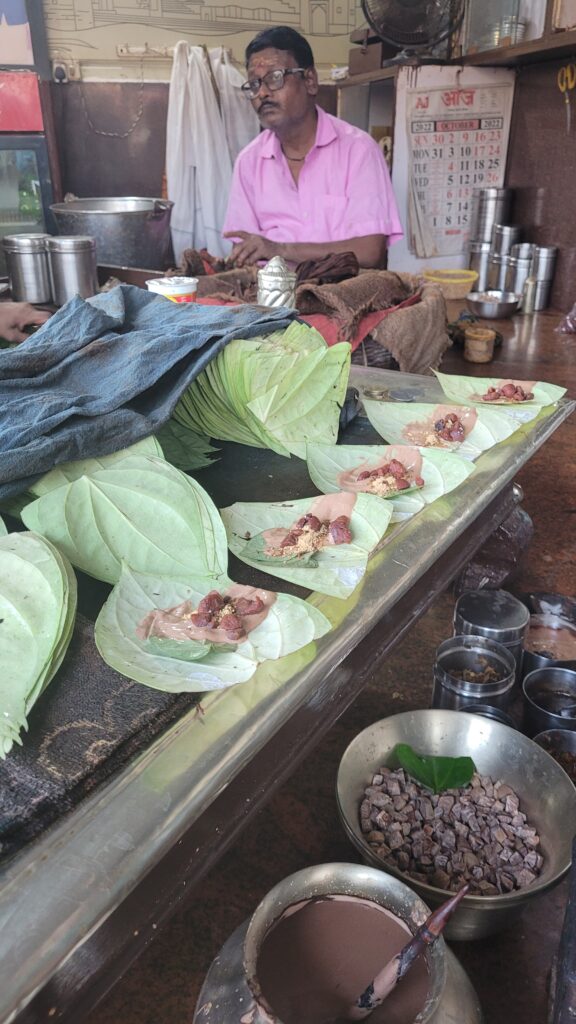
Sailing Along the Ganges at Dusk
As the day came to a close, and the sky grew darker, we made our way to Ravidas Ghat, where we would be boarding the Alaknanda Cruise Liner for a special 2 hour evening cruise along the Ganges. This was our final excursion for the day, and ultimately, the last section of our Banaras trip! I had been awaiting this experience the entire day, so I was genuinely excited when the time finally arrived!
We boarded the boat around 7:00 PM. Our boat was a bi-level vessel with an open top level lined by a rail balcony along the periphery, and a covered bottom level. We were free to move about the boat once the vessel departed the port. We climbed up to the open air second level within 10-15 minutes. One unique aspect of this cruise is that it allows one to pass by all of the 85 ghats. Luckily, on this day, the skies were clear, so we were able to enjoy the ride very much. As the vessel picked up speed, the winds became quite refreshing!
Sailing along the waters during the early morning hours is one thing, but at night, the river ghats become an even grander spectacle. I would liken the Ganga’s daytime river persona to a beautiful, fair and calm maiden dressed in a floral gown, while at night, she becomes a flashier, wilder, and bedazzled version of herself. As twilight drew near, bright, colorful beams of lights rose from the river along the shore. I realized that the ghats were all decorated and shining. Parallel strings of yellow lights wrapped the historical temples and buildings, creating an exquisite sight. Since our visit occurred during Diwali, the festival of lights, we were quite lucky to behold such a spectacular display.
About halfway through our sailing trip – perhaps about an hour in – our vessel stopped in the middle of the river. For a moment, I wondered what was happening. But I caught sight of Assi Ghat – our prior home! And we had arrived just in time for the Ganga Aarti. We remained there, floating for approximately a half hour, viewing the Ganga Aarti from a brand new vantage point. Just when we thought the spectacle was complete, I heard a resounding clap, and upon greeting the black skies, caught sight of a shower of sapphire and electric blue lights!
Fireworks!
It was too incredible to be true! We all stood frozen in awe… we were bewildered. I could hardly wrap my mind around what was occurring: we were floating in the midst of the Ganga River… at around 8 PM… viewing a most divine Diwali Fireworks display against the backdrop of the Ganga Aarti along Assi Ghat! Even typing these words two months later, I cannot believe I was really there to experience such a magical sight. Over the course of the remainder of the cruise, I felt like I was in a dream. It was beyond words…really beyond words… Being there was such a surreal thing… although photos will never capture the true essence of these moments, it will surely provide a little taste… So Enjoy…
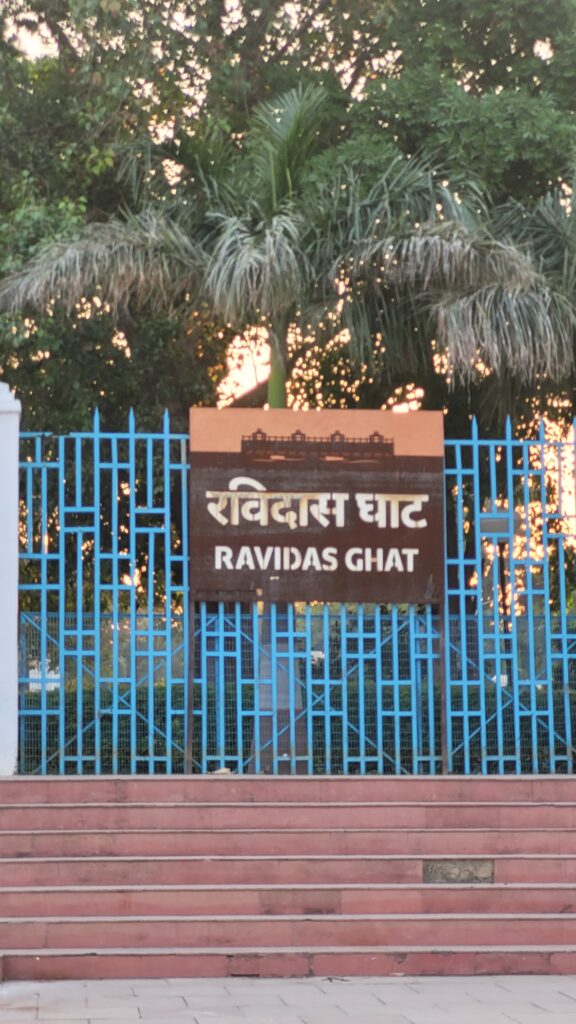



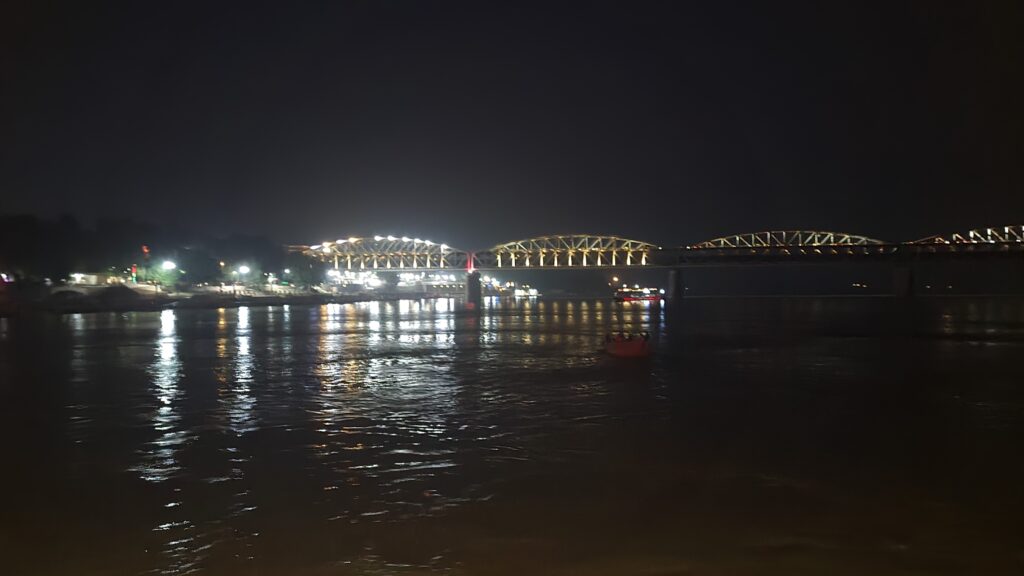
Goodbye to the City of My Dreams
The Ganga Evening Cruise provided a storybook ending to the most perfect 4-day journey through Banaras I could ever have imagined. This city is a radiant gem in North India, a spiritual wonder, a pilgrimage site, a home for those who seek salvation…it is a place unlike any other I have ever experienced…a journey through time and space… and that is the raw truth! It is, and will always be, the city of my dreams….
Thank You for joining me on my special trip. I hope you are inspired to travel to Banaras someday soon… or return there, if you are lucky to have visited once… And As Always… Thank You very much readers! 🙂 Keep Exploring Your World…Goodbye for now…
